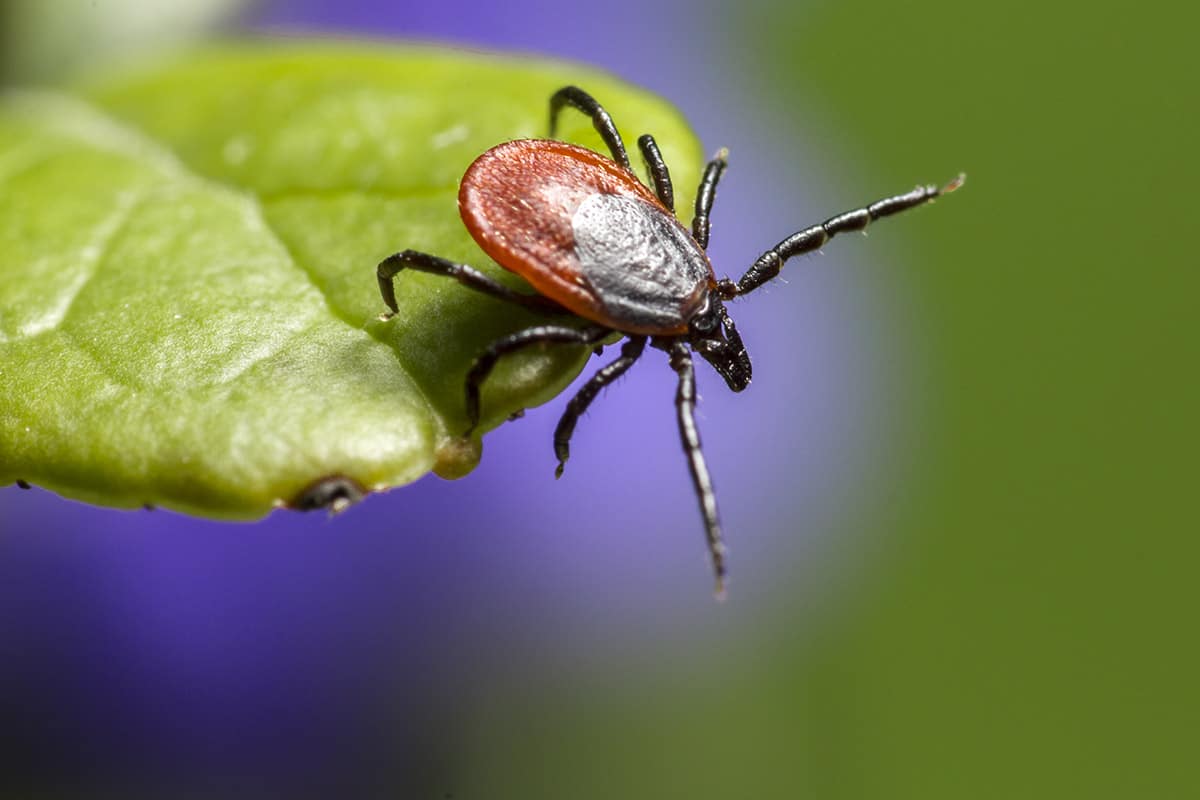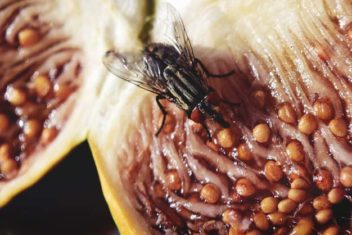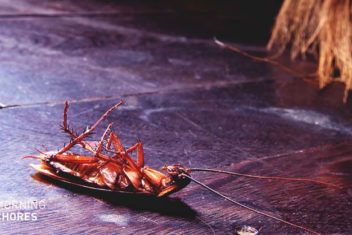Want to strike fear in the heart of someone? Just mention the word “ticks.” These arachnids carry different diseases that affect both animals and humans, and some of the diseases can make you really sick.
You’ve probably heard of Lyme disease, and Rocky Mountain spotted fever, right? So how do you know what the ticks look like that spread these awful diseases, and what do you do if you come across them?
Let’s take a look at some of the most common ticks to watch for and what you need to do if one starts sucking on you.
9 Common North American Ticks
If we were to go into a full list of all the tick species (and sub-species) around the world, you’d be reading for a while. This is because there are about 900 known tick species worldwide. Instead of boring you into a coma, we’ve provided a list of the 9 most common ticks to watch out for in the USA and Canada.
Although many ticks look alike, it’s good to be able to tell the differences between them. Quite often, the key to identifying which species you’re dealing with is the insect’s scutum, which is a shield-like plate on its back.
Different species have unique patterns and colors here, so be sure to familiarize yourself with them.
1. American Dog Tick (Dermacentor variabilis)
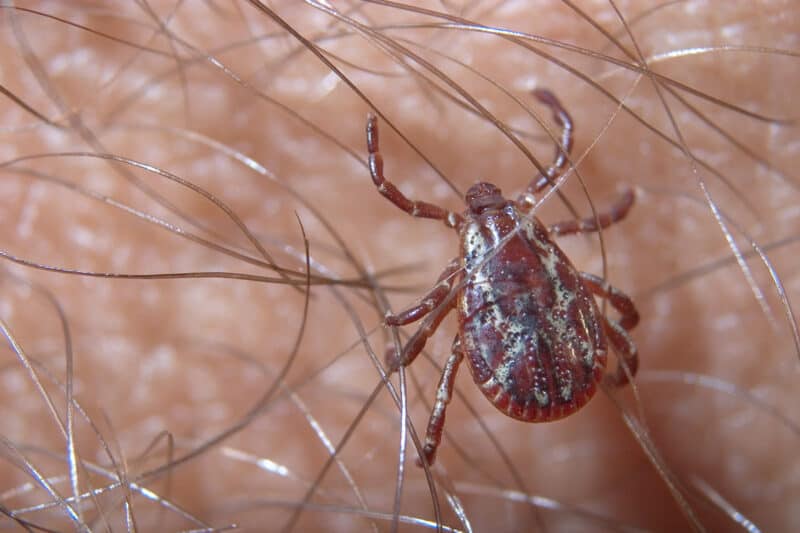
Although these don’t carry Lyme disease, they can offer Rocky Mountain fever to humans that they bite. They also carry canine ehrlichiosis and canine babesiosis, hence their “dog tick” moniker. These two conditions can cause bleeding disorders, anemia, lethargy, and inflammation in dogs.
Check your pets thoroughly after being out in the forest with them to help keep them healthy.
Additionally, these ticks can also cause tick bite paralysis in both animals and humans. This is thanks to a neurotoxin they exude. Keep an eye out for sudden muscle weakness as a clue that this may be the tick responsible.
2. Eastern Black-Legged Tick (Deer Tick) (Ixodes scapularis)
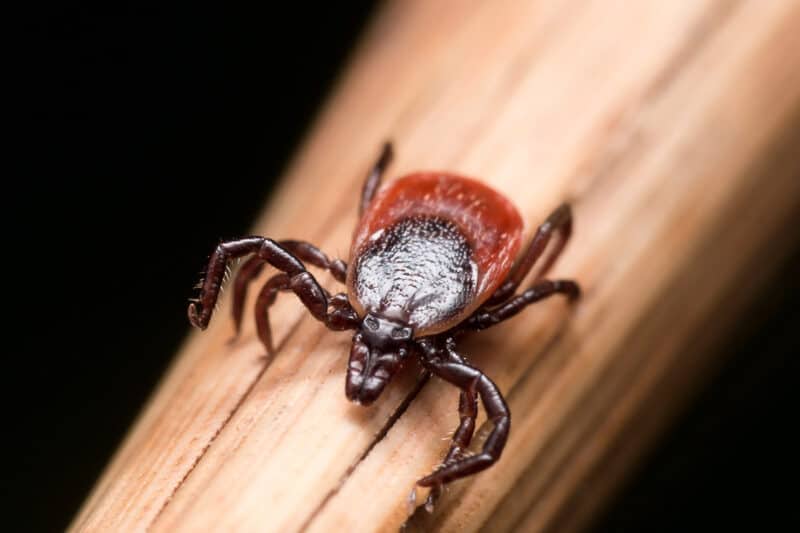
The deer tick is also known as the Eastern black-legged tick and is the primary Lyme disease carrier in North America. Interestingly, although male ticks can attach to passersby, they don’t feed and engorge when they do. It’s only female nymphs and adult females that feed, engorge, and can pass along Lyme disease.
The adult females’ bodies are red-orange with dark brown shields and black legs and are significantly bigger than males. They’re often present on white-tailed deer and can be found from the Midwestern states to the East Coast. In Canada, you’ll find them from Saskatchewan through to Newfoundland and Labrador.
Depending on your location, you’re most likely to get bitten by them between late March and early September. Hikers, campers, and hunters are susceptible to tick bites, as people who may get too close to a fresh deer carcass, such as pulling roadkill off to the side of the road.
3. Brown Dog Tick (Rhipicephalus sanguineus)
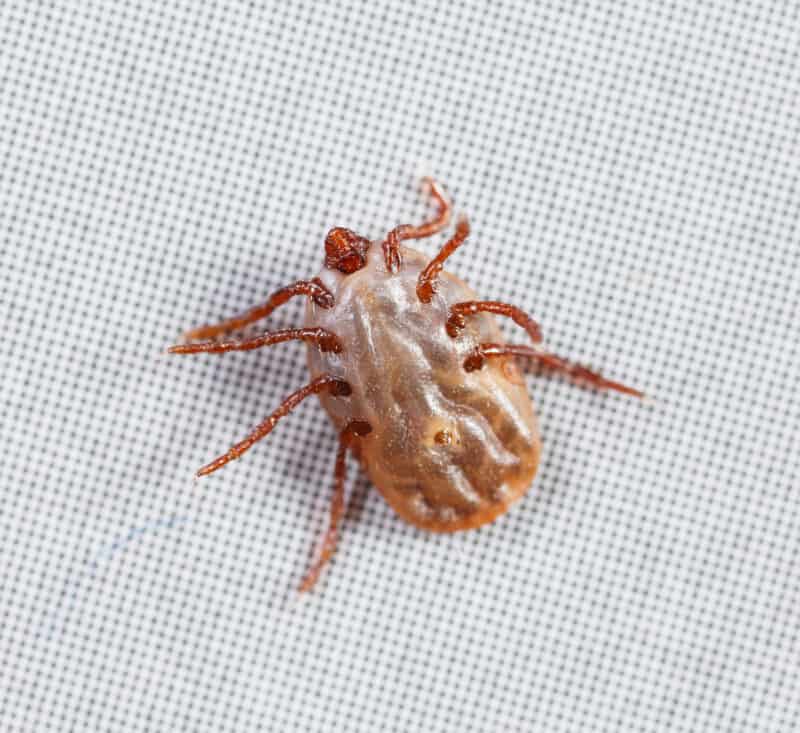
These reddish-brown ticks have no discernible markings, which actually makes them fairly easy to identify. Both males and females are rusty colored, though they can turn blue-gray after they’ve fed. They’re about 1/8″ in length but can get larger once engorged.
Like the American dog tick, these carry illnesses that affect animals more than humans. That said, they can also cause fevers and bacterial infections, so be cautious. You can find them absolutely anywhere in the US and most of Canada, Europe, Asia, and Australia. These also seem to like living in people’s houses, so keep your eyes open.
4. Groundhog Tick (Ixodes cookei)
Also known as the Woodchuck tick, this species is cream-colored with a reddish-brown shield. It’s mostly found in the eastern US and Canada, in wooded areas, and along the edges of fields. This species doesn’t carry Lyme, but it can spread Powassan virus disease. The good news is that it isn’t particularly aggressive and doesn’t like to bite humans.
(How much wood would a woodchuck chuck if a woodchuck could chuck ticks? I am so sorry.)
5. Gulf Coast Tick (Amblyomma maculatum)
You have three guesses as to where these like to set up shop. They thrive in Alabama, Virginia, Georgia, and Florida, though you may also find them in Arizona and New Mexico. They tend to attach themselves to rodents, birds, and humans, though they will bite humans too if they’re available.
These ticks have light brown bodies with silver-white web-like lines on their shields. While they don’t carry Lyme disease, they may transmit Rocky Mountain fever.
6. Lone Star Tick (Amblyomma americanum)
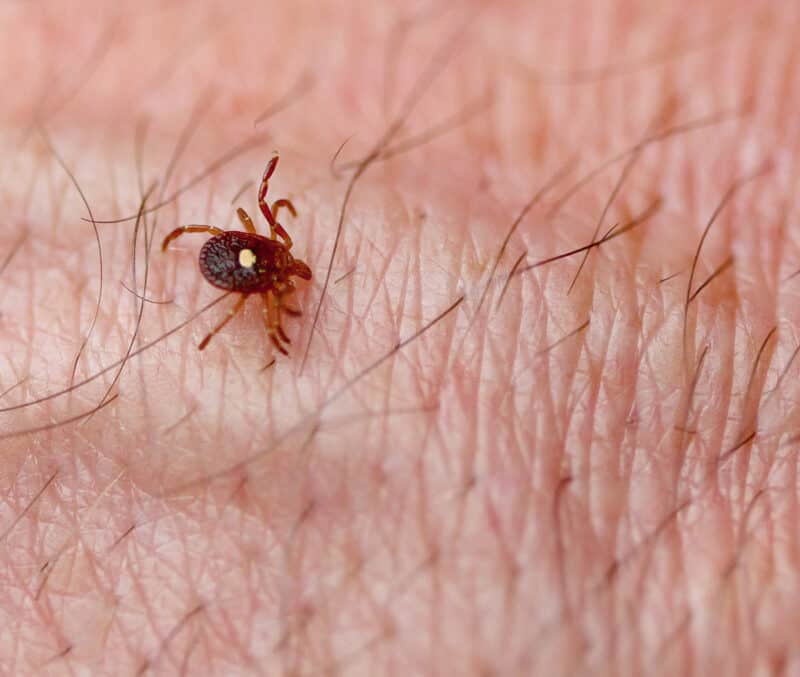
You’ll find this guy from Iowa to Maine and down to Texas and Louisiana. It’s easily identifiable because it has a single white dot (hence the “Lone Star” moniker”) in the middle of its red-brown back.
Now, this complete jerk of a tick is quite aggressive and seems to enjoy biting humans. Not only does it spread diseases like ehrlichiosis, tularemia, and Heartland virus disease, it can also cause alpha-gal allergy. Yeah, that’s the one that makes the person allergic to red meat.
7. Soft Tick (Ornithodoros spp.)
These ticks have soft bodies rather than hard carapaces, hence their name. Instead of biting and digging in to feed for days, they’ll feed for 20 min or so before dropping off. They don’t like woodlands or tall grasses but instead make their homes in and around rodent and lagomorph burrows. They have soft, brown, oval bodies and small heads. Once they’ve fed, they look like brown tumors.
You can find these throughout the Western mountains, especially in Washington State, Oregon, California, and Colorado. These don’t carry Lyme but can cause tick-borne relapsing fever (TBRF).
8. Western Black-Legged Tick (Ixodes pacificus)
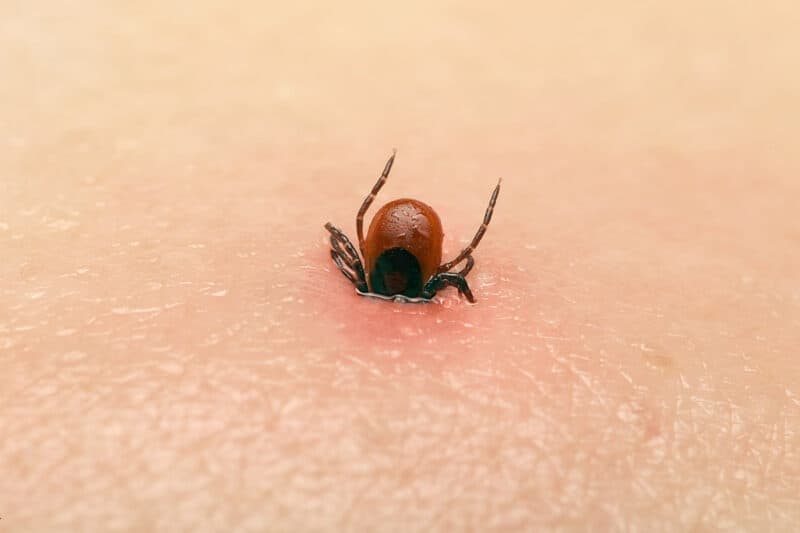
Since common deer ticks are also known as Eastern black-legged ticks, you can bet that these Western cousins look quite similar. In fact, their only discernible difference is that their bodies are more oval in shape. They’re only found on the west coast from Mexico to northern Canada and like wooded areas close to water.
While these ticks prefer to feast on lizards and birds, they carry both Lyme disease and anaplasmosis. The nymphs are most active from May to August, while adults feed most from August to November.
9. Wood Tick (Dermacentor andersoni)

This one is also called the Rocky Mountain wood tick and is found in mountainous regions throughout the NW United States and SW Canadian Provinces. It’s the main vector for conditions known as Rocky Mountain spotted fever, Colorado tick fever, and tularemia (aka “rabbit fever”). [1]
Wood ticks have flat, pear-shaped bodies, and their undersides are reddish-brown in hue. The males have gray and white spots on their backs, while the females have pale silvery backs.
How to Deal With Them
Below are some great ways to deal with ticks, whether you’re aiming for prevention or treatment. A bit of extra diligence and care goes a long way when it comes to these bugs.
Use Preventive Measures Whenever Possible
Prevention is one of the best ways to ensure a tick-free existence. Be sure to wear long-sleeved clothes with tight weaves whenever you’re out in the woods. If you’re out hiking, stick to walking in the middle of trails, away from tall weeds, thick grass, and shrubberies. Additionally, if you’re foraging for wild edibles, wear gloves that secure tightly at the wrist.
Since I live in a forested area, I use an insect-repelling salve to help fend the beasties off. I slather this stuff on in addition to wearing long pants and high boots whenever I go traipsing around in the woods. In fact, not only do I spread it between my toes and around my ankles, but I also wipe some of it around my boot laces.
This prevents the little bastards from trying to crawl their way in where they’re not wanted.
If you’d prefer to use more heavy-duty measures, you can spray your boots/shoes and pants with a spray that contains DEET. Don’t use this directly on the skin, and avoid using it around animals and small children.
Use a light-colored tarp to sit on if you’re going to hang out on the grass for a while. Additionally, check yourself, your kids, and your outdoor animals thoroughly to ensure they’re tick-free. Bites can affect various animals differently, so be diligent.
Once you’re home, throw all your clothes into the dryer on a hot cycle for 10–15 minutes. The high heat will kill both adults and nymphs. Then shower thoroughly, checking yourself for bites as you do so.
Repellent Ideas
Ticks are sensitive to scents, and the following essential oils are the most effective at keeping them at bay:
- Cedar
- Clove
- Rose Geranium
- Oregano
- Rosemary
- Citronella
- Lemon Eucalyptus
- Thyme
- Neem
- Peppermint
What to Do if you Find a Tick
First and foremost: don’t panic. Yes, they’re gross, and it’s unnerving to have one in your skin (or on your kid or your dog), but you can deal with them quickly and easily.
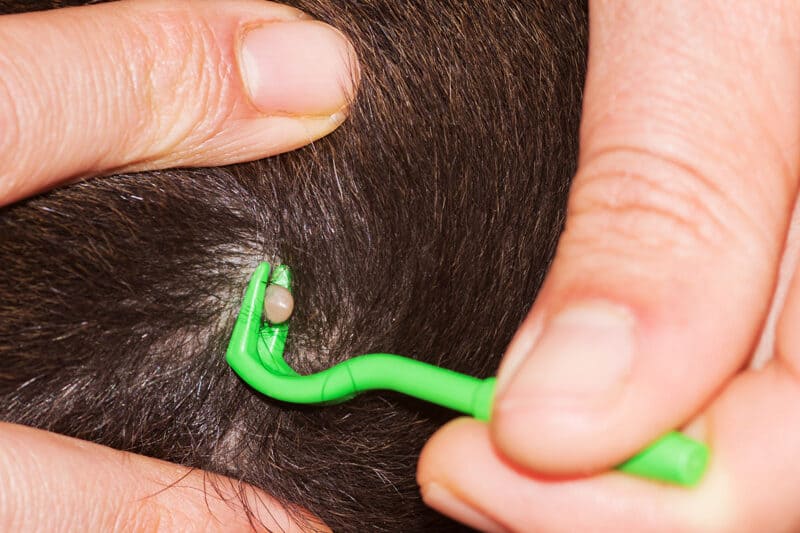
Burning ticks off by heating their backsides is not an ideal solution. Instead of letting go, having a fire literally under their asses will make ticks burrow more deeply into your flesh. Since you don’t want that, use this technique instead:
- Grab a pair of fine-pointed tweezers, not flat-ended ones.
- Get as much of the tick between the tweezers as possible, close to the skin
- Once you have a firm grip on it, pull it out slowly and firmly with a steady, even pressure
- Try not to crush or squish it as you do so otherwise it may leak into your body and cause an infection
- After it’s out, kill it
- Then wash your hands, the tweezers, and the affected area with soap and warm water
- If there are any bug bits left in your skin, just leave them there
That last tip might sound weird, but there’s a reason for it. As your body heals from the bite, your skin will push out any foreign bits left in the wound. Anyone who’s ever experienced a rejected piercing knows what that’s like.
These bug bits won’t release any toxins into your body if they’re left in there. However, what will cause more damage is if you take those tweezers (or a knife) and dig into the wound to try to get them out. That’s more likely to cause an infection, so just leave it alone.
Notes on Lyme Disease
Keep in mind that only deer ticks (aka eastern black-legged ticks) carry Lyme disease in the US and Canada. Additionally, even though approximately half of deer ticks carry Lyme disease, simply being bitten doesn’t mean that you’ll get it too.
This is because the tick needs to feed on its host constantly for 36 to 48 hours before it can pass along the Lyme-infected Borrelia burgdorferi spirochetes. On top of that, your risk of actually getting Lyme disease from a tick bite is lower than 3%.
Despite these low percentages, it’s important to check yourself for bites every time you head home from the woods. Remember that you won’t feel a bite because of the analgesics they exude. Basically, they don’t want to be felt: they want to be left alone to suck blood out in peace.
When to Seek Medical Attention
If a large red ring appears around the bite location, even if it’s weeks later, that can indicate infection or Lyme disease. This type of rash is called erythema migrans (EM) and is also known as a “bull’s eye” rash. It can be as large as 12″ across (if not bigger) and is characterized by a red outer ring with a smaller red rash in the center.
Furthermore, if that redness is associated with a fever, joint pain, dizziness, or paralysis, it’s important to see a healthcare practitioner. The standard treatment is antibiotics over a two- to three-week period. Additionally, the patient may be instructed to make dietary changes to reduce inflammation.
Alternatively, if your healthcare provider is a naturopathic doctor or herbalist, they may recommend cat’s claw (Uncaria tomentosa) and/or sweet wormwood (Artemisia annua) to combat the illness. In a 2020 study from Johns Hopkins University, both of these plants were shown to be even more effective than certain antibiotics for fighting Borrelia. [2]
If the patient is non-human, then the veterinarian will likely have several different options available as well. Do proper research to determine the best treatment for the person or animal affected, as required. Then be sure to take proper follow-up care and try to prevent re-infection as best you can.
References:
- Mörner T (December 1992). “The ecology of tularaemia“. Rev. Sci. Tech. 11 (4): 1123–30. doi:10.20506/rst.11.4.657. PMID 1305858.
- Feng J, et al. Evaluation of Natural and Botanical Medicines for Activity Against Growing and Non-growing Forms of B. burgdorferi. Frontiers in medicine. 2020; 7: 6.
